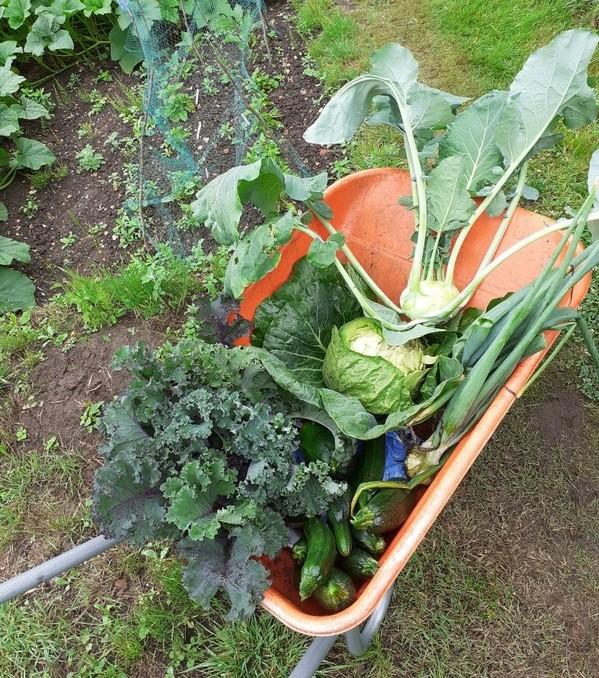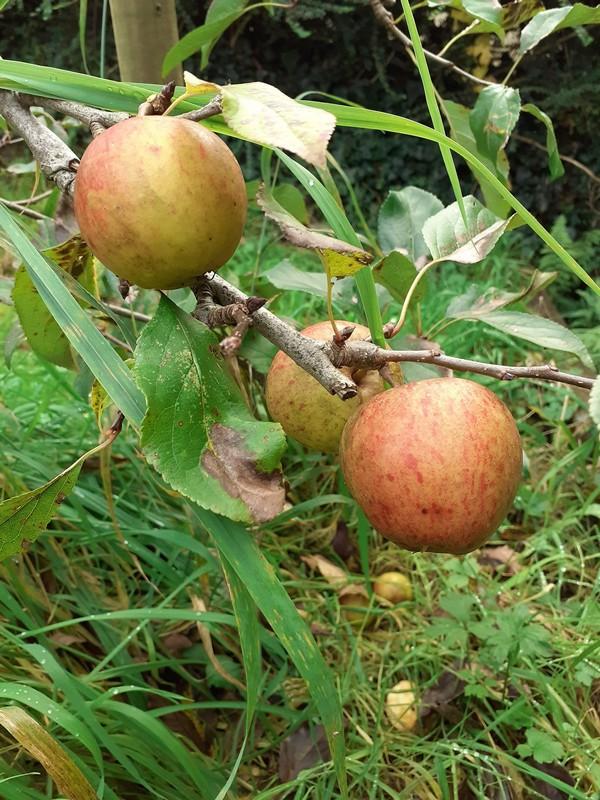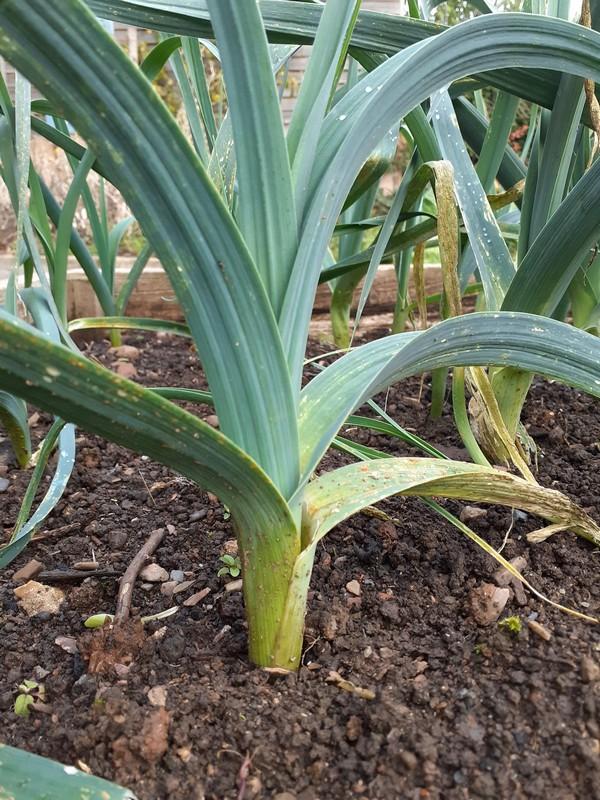
Maybe joining a community group isn't up your street, but you'd like to give it a try at home.
Not sure when to start?
The usual sowing months are March - May, so that the plants are ready for summer growing June - September. Get your seeds in advance (try garden centres, supermarkets, on-line or your local seed swap) and look at the packet, all the guidance will be on there. Get organised and make sure you have your patch or pots prepared.
Itching to get your hands dirty?
There are plenty of things you can do to get prepared:
- Get on top of the weeds during the winter by covering the ground with some carboard, old carpet or wood. Uncover the ground in February and clear the dead weeds easily, no chemicals needed.
- If you fancy some DIY and don't have a veggie patch, why not try building some planters ready for the spring?

Starting in summer?
You may be worried you’re too late to get stuck in this year, stay with us! There are several vegetables which can handle late planting and autumn/winter harvests, including rocket, chard, potatoes, and carrots. Find out more about planting all year round.
No veggie patch or not much space?
Ideas for windowsill growing:
You can also grow lots of food in pots and containers:
- Advice for growing crops in containers
- Suitable varieties for containers
- Make your own reservoir container worksheet
Worried about the physical exertion of maintaining a patch?
Try no-dig! The idea of no-dig is to make growing easy for you, if you have issues with mobility or just don’t like the idea of digging. This approach leaves soil undisturbed, and the soil (and subsequently the plants) is fed with organic matter on the surface, as happens in nature, maintaining drainage and aeration.
Not sure if you'll be able to eat or use it all in time?
Lots of foods can be stored for long periods of time, without losing their quality.

- Potatoes can be washed and dried, then stored in a dark, frost free space. Check occasionally for mouldy ones.
- Spare picked apples can be stored in a dark, dry, frost free space. Check occasionally for mouldy ones. Do not try to store windfall apples, they will rot.
- Squash and pumpkins can be stored in a cool, dark space. Perfect for those winter soups.
- Plenty of fruit and veg can be frozen and kept for later.
- Runner beans and courgettes can often grow faster than you can eat them, so slice them before freezing in portions.
- Apples can be stewed and frozen, and soft fruit such as raspberries and strawberries can be frozen as picked (remove any leaves and stalks first), ready for winter puddings.
- Tomatoes can be frozen and then used in sauces, bolognaise or stews.
- Fresh herbs can be picked and frozen, then added straight into sauces whilst cooking.
If you fancy getting creative in the kitchen, you could even store your produce as preserves:
- All soft fruits can be turned into jam if you have an excess
- Lots of veggies such as runner beans, squash and beetroot can be made into chutneys
- Many vegetables are great for pickling, such as cabbage, beetroot and courgette. You can try just about anything here!
For more information…
Be sure to check out Zing Somerset's growing guide for more tips and guidance for beginners.
The Royal Horticultural Society have a very comprehensive A-Z of growing fruit and veg, which takes you step by step through the sowing, growing and harvesting process of each one. You'll even find a recipe suggestion for each item, ensuring that you always make the most of your well-earned produce!
However, if you don't have enough space consider the possibility of...
Garden Share
The text below is from the Building Local Food Systems Handbook, produced by the fabulous Food Matters, a well researched, well written article about creating a garden share scheme:
How to Grow Your Neighbour's Own
Introduction
Gardening and growing food is no longer a Sunday afternoon hobby, reserved for the few lucky enough to have a sunny back garden. It’s a serious business! Sharing gardens between owners who can’t or don’t want to grow, and enthusiastic growers without space, is a solution to getting fresh tasty vegetables, more cheaply. There is a real and growing demand for fresh, local, organic vegetables, but it’s not always cheap. In cities and large urban areas, where nine out of ten of British people live, green spaces to grow are scarce. And as for allotment sites, the waiting lists are often long and sometimes endless. Access to land to grow on can be a real problem. One solution is to grow on that patch next door – your neighbour’s.
The origin
It all started from a different outlook. Charities and organisations working with isolated elderly people would organise visits from younger people to help look after the elderly person’s garden, when it was becoming too difficult for them manage. They wouldn’t have to worry about their garden becoming overgrown; they would get company, possibly be able give gardening advice and sometimes even get fresh veg or flowers in return.
The need for tasty vegetables and the lack of space to grow them have pushed local groups to develop sharing schemes between garden owners and landless growers. More than getting vegetables, these schemes bring people together – building friendships, sharing knowledge and affording the unique satisfaction of growing your own food from start to finish.
Starting a garden-sharing scheme in your local area
The success of garden-sharing schemes is largely due to existing community groups and the presence of a strong food-growing culture. The size of the city is important, as it informs the way schemes work. Successful schemes such as Grow Your Neighbour’s Own in Brighton or Edinburgh’s Garden Share Scheme work quite differently. For large cities, a more formal approach is necessary, with more legal requirements, often with the involvement of a council department or voluntary sector organisation to support the scheme. In smaller cities and urban areas, a volunteer group would be able to cope with organising and managing up to a hundred contacts.
Organising a garden sharing scheme is easier around a pre-existing community group, as it will be far simpler to reach people through an organisation they already know. However, if no local food-growing culture exists in your area, the best way to get people together and growing is to go back to the roots of the scheme. Age Concern or charities and other organisations working with vulnerable communities may welcome such initiatives.
Sharing your garden with someone you don’t know, or growing in somebody else’s garden, can sound a bit surprising at first, and may cause some people to feel anxious. With existing garden-share schemes, there tends to be a dropout rate of between 30 and 40%, so it’s absolutely crucial to start small and to be very clear with potential swappers about what’s involved. Not everybody will have the skills or the time needed to suit a garden owner’s expectations. Equally, a potential grower may have very different expectations, so phone conversations followed by face-to-face meetings will help adjust expectations and make for more successful garden share matches.
Once set up maintaining a contact database shouldn’t require more than one person working part time if the scheme stays relatively small say under 100 shared garden. Indeed, once you’ve matched owners and growers, each match is more or less self-managed, although is important to get feedback to make sure your owners and growers are happy with the match.
How to choose your garden and growers
There are some basic rules that it would be helpful to follow:
- Avoid gardens with a limited amount of sun (e.g. north-facing or over shadowed)
- Avoid gardens with no direct access (i.e. not going through the garden owner’s house)
- Ensure everyone has an up-to-date Criminal Record Bureau (CRB)
Getting people on your scheme
The most important thing is to start small. Stay within your ward or local area, as it will be easier for you to reach people via promoting it in the local shops and library. This also ensures owners and growers will be geographically close to each other. Garden-sharing schemes appear to work best in urban areas because that’s where you get the most people who might be interested in growing without having any space to grow. Distance is an important factor. Most growers will be reluctant to travel too far, and rural areas are more likely to increase the average distance between land providers and growers. For this reason, garden-sharing schemes tends to work best in low to mid-density urban areas.
Promotion
It is easy to forget that not everybody has internet access at home especially elderly people who are a significant part of owners in garden-sharing schemes. Although promoting your scheme online is necessary, it shouldn’t be your main way of communicating. Universally, passionate individuals are what make a great garden- sharing scheme. Try to get support from local people who are really passionate about growing and encourage them to be your local ambassadors. They will be able to promote your scheme in their area and perhaps give talks at the local horticultural society, local schools or other local events.
Funding
This part is slightly tricky because the main emphasis of garden-share schemes (sharing between individuals) probably won’t fit many funders’ criteria, which often focus on ’a benefit to the community’. Your scheme will obviously contribute to your local area, but this will be difficult to prove. From a funder’s point of view, your scheme will be for private interest. However, you may be able to access funding to offer services, including workshops and training sessions for growers to learn basic gardening skills and knowledge.
Further information & examples
Gardening Together is a garden share scheme in Frome, which is linking people with gardens with local people who want to grow food.